金融数学课件(英文版)第5讲
- 格式:pdf
- 大小:667.04 KB
- 文档页数:24
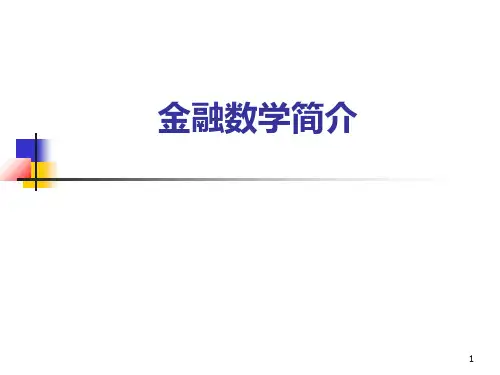

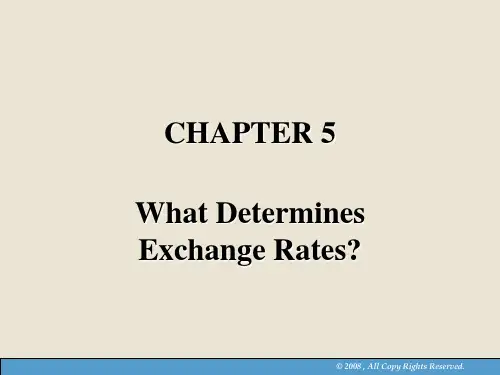

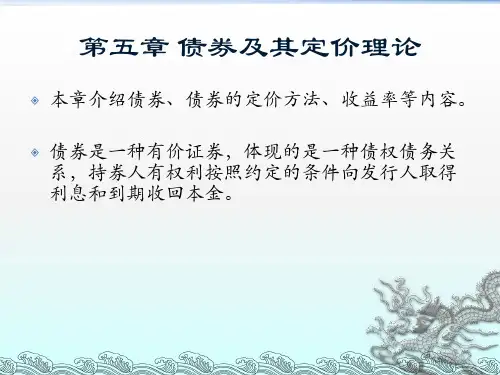
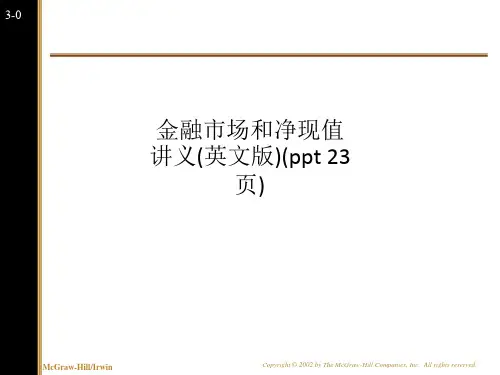

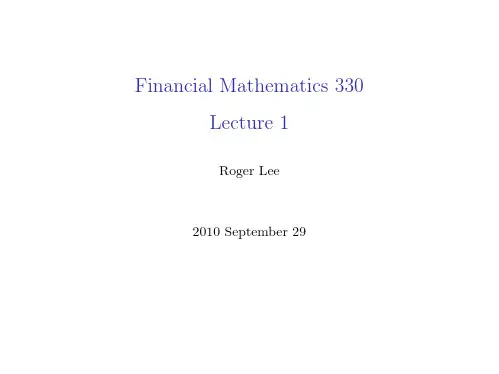
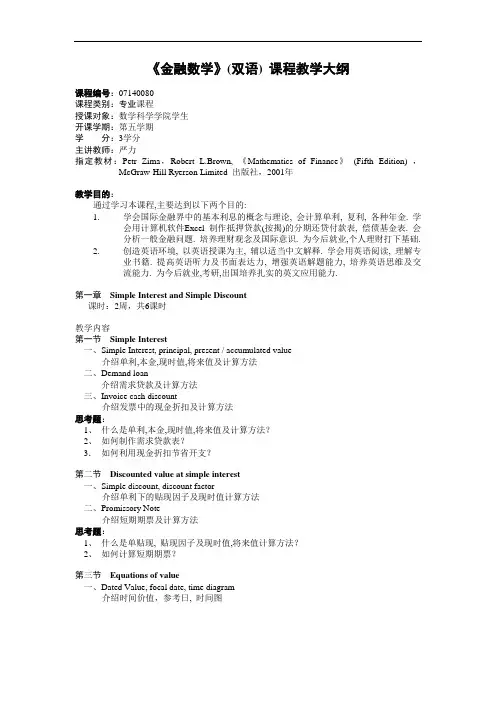
《金融数学》(双语) 课程教学大纲课程编号:07140080课程类别:专业课程授课对象:数学科学学院学生开课学期:第五学期学分:3学分主讲教师:严力指定教材:Petr Zima,Robert L.Brown, 《Mathematics of Finance》(Fifth Edition) ,McGraw-Hill Ryerson Limited 出版社,2001年教学目的:通过学习本课程,主要达到以下两个目的:1.学会国际金融界中的基本利息的概念与理论, 会计算单利, 复利, 各种年金. 学会用计算机软件Excel 制作抵押贷款(按揭)的分期还贷付款表, 偿债基金表. 会分析一般金融问题. 培养理财观念及国际意识. 为今后就业,个人理财打下基础.2.创造英语环境, 以英语授课为主, 辅以适当中文解释. 学会用英语阅读, 理解专业书籍. 提高英语听力及书面表达力, 增强英语解题能力, 培养英语思维及交流能力. 为今后就业,考研,出国培养扎实的英文应用能力.第一章Simple Interest and Simple Discount课时:2周,共6课时教学内容第一节Simple Interest一、Simple Interest, principal, present / accumulated value介绍单利,本金,现时值,将来值及计算方法-二、Demand loan介绍需求贷款及计算方法三、Invoice cash discount介绍发票中的现金折扣及计算方法思考题:1、什么是单利,本金,现时值,将来值及计算方法?2、如何制作需求贷款表?3.如何利用现金折扣节省开支?第二节Discounted value at simple interest一、Simple discount, discount factor介绍单利下的贴现因子及现时值计算方法二、Promissory Note介绍短期期票及计算方法思考题:1、什么是单贴现, 贴现因子及现时值,将来值计算方法?2、如何计算短期期票?第三节Equations of value一、Dated Value, focal date, time diagram介绍时间价值,参考日, 时间图二、Equations of value介绍时间价值计算方法三、Property of transitivity介绍等价概念思考题:1、什么是时间价值及计算方法?2、如何判定等价的时间价值?第四节Partial payment一、Merchant’s Method思考题:1、如何用商人法则计算余额?2、如何用递减法则计算余额?第五节Simple discount at a discount rate一、Simple Interest, principal, present / accumulated value介绍单贴现, 贴现因子及现时值,将来值计算方法- 二、Equivalent relationship介绍等价的贴现率与利率的计算方法思考题:1、什么是单贴现,本金,现时值,将来值及计算方法?2、什么是单贴现率与利率的等价关系及计算方法?第二章Compound Interest and Compound Discount 课时:5周,共15课时第一节Fundamental compound interest formula一、Fundamental compound interest formula介绍基本复利计算公式二、Compound Interest, principal, present / accumulated value介绍复利,本金,现时值,将来值及计算方法-思考题:1、什么是复利,本金,现时值,将来值及计算方法?2、什么是复利和单利的区别?第二节Equivalent compound interest rate一、Annual effective rate, nominal rate介绍年有效利率及名义利率计算方法二、Equivalent relation介绍两等价名义利率的计算方法思考题:1、什么是有效利率及名义利率?2、如何转换两等价名义利率?第三节Discounted Value at Compound Interest一,Present value, compound discount, discount factor 介绍现时值,复贴现,贴现因子及计算方法二、Long-term promissory note介绍长期票据及计算方法思考题:1、什么是现时值,复贴现,贴现因子及计算方法?2、如何计算长期票据?3.什么是长期票据和短期票据的区别?第四节Accumulated and Discounted Value for a Fractional Period of Time一、Exact / Theoretical method介绍理论计算方法-二、Approximate / Practical method介绍实用计算方法思考题:1、什么是理论计算方法?2、什么是实用计算方法?3.什么是理论和实用计算方法的区别?第五节Finding the Rate and the Time一、Finding the rate介绍利率计算方法-二、Finding the time介绍期限计算方法思考题:1、什么是利率计算方法?2. 什么是期限计算方法?第六节Equations of value一、Dated Value, focal date, time diagram介绍时间价值,参考日, 时间图二、Equations of value介绍时间价值计算方法三、Property of transitivity介绍复利等价概念思考题:1、什么是复利时间价值及计算方法?2、如何判定复利等价的时间价值?第七节Compound Interest at Changing Interest Rate一、Finding the interest at Changing Interest Rate介绍利率改变后利息计算方法-二、Finding the present value at Changing Interest Rate介绍利率改变后现时值计算方法思考题:1、如何计算不同利率阶段的利息?2、如何计算不同利率阶段的本金?第八节Other Applications of Compound Interest Theory, Inflation and the “Real” Rate of Interest一、Economics application介绍经济应用-二、“Real” Rate of Interest介绍“实值”利率及计算方法三,Inflation / Deflation介绍通货膨胀和通货紧缩思考题:1、什么通货膨胀和通货紧缩?2,什么是“实值”利率及计算方法?第九节Continuous Compounding一、Finding the rate of continuous Compounding介绍连续利率计算方法-二、Finding the present value and future value介绍连续利率时现时值与将来值计算方法思考题:1、什么是连续利率计算方法?2、什么是连续利率与其他利率的关系?第十节Compound Discount at a Discount Rate and Equivalent Discount Rates 一、Finding the Compound Discount Rate介绍复贴现率计算方法-二、Finding the present value and future value介绍复贴现率时现时值与将来值计算方法三T-bill介绍债劵思考题:1、什么是复贴现率计算方法?2、如何计算复贴现率时现时值与将来值?3,什么是债劵及计算方法?第三章Simple Annuities课时:3周,共9课时第一节Definitions一、Simple, general, ordinary, due, deferred annuities介绍简单,普通,初付,延付及延期年金二、Notations介绍惯用符号-思考题:1、什么是简单,普通,初付,延付及延期年金?2、什么是不同年金的区别?第二节Accumulated Value of an Ordinary Simple一、Accumulated Value介绍简单延付年金累积值计算方法二、Payment介绍简单延付年金复费计算方法思考题:1、什么是简单延付年金累积值计算方法?2、什么是简单延付年金复费计算方法?第三节Discounted Value of an Ordinary Simple Annuity 一,Discounted Value介绍简单延付年金现时值计算方法二、Decision making决策制定思考题:1、什么是简单延付年金现时值计算方法?2、如何根据净现时值制定决策?第四节Other Simple Annuities一、Annuity due介绍初付年金计算方法-二、Deferred annuity介绍延期年金计算方法思考题:1、什么是初付年金计算方法?2、什么是延期年金计算方法?第五节Finding the Term of an Annuity一、Finding the term介绍期限计算方法-二、Concluding payment介绍最后付费计算方法思考题:1、什么是期限计算方法?2,什么是最后付费计算方法?第六节Finding the Interest Rate一、Finding the Interest Rate介绍利率计算方法二、Linear interpolation介绍线性插值计算方法思考题:1、什么是利率计算方法?2、什么是线性插值计算方法?第四章General and Other Annuities课时:3周,共9课时第一节General Annuities一、General annuities介绍普通初付,延付及延期年金二、Application综合应用思考题:1、什么是普通,初付,延付及延期年金?2、如何计算不同年金?第二节Mortgages in Canada二、Mortgages介绍抵押贷款计算方法二、Small payment介绍小付费计算方法思考题:1、什么是抵押贷款计算方法?2、什么是小付费计算方法?第三节Perpetuities一,Perpetuities介绍永久年金现时值计算方法二、Payment介绍永久年金付费计算方法思考题:1、什么是永久年金计算方法?2、如何区别永久年金和普通年金?第四节Annuities where Payment Vary一、Geometric progression介绍几何级数变化计算方法-二、Arithmetic progression介绍算术级数变化计算方法思考题:1、什么是几何级数变化计算方法?2、什么是算术级数变化计算方法?第五章Amortization Method and Sinking Funds 课时:5周,共15课时第一节Amortization of a Deb t一、Amortization schedule介绍贷款清偿表的制作二、Outstanding principle balance介绍本金余额计算方法思考题:1、什么是贷款清偿表计算方法?2、什么是本金余额计算方法?第二节Outstanding Balance一, Retrospective method介绍过去计算方法二、Prospective method介绍将来计算方法思考题:1、什么是过去计算方法?2、什么是将来计算方法?第三节Refinance a Loan-the Amortization Method 一,Amortization Method介绍重新贷款计算方法1二、Decision making决策制定思考题:1、什么是重新贷款计算方法1?2、如何根据罚金制定决策?第四节Refinance a Loan the Sum-of-Digits Method一、Sum-of-Digits Method介绍重新贷款计算方法2-二、Deferred annuity介绍延期年金计算方法思考题:1、什么是重新贷款计算方法2?2、什么是计算方法1和计算方法2的区别?第五节Sinking Fund一、Sinking Fund介绍偿债基金计算方法-二、Schedule介绍偿债基金表的制作思考题:1、什么是偿债基金?2,如何制作偿债基金表?第六节The Sinking-Fund Method of Retiring a DebtRetiring a Debt介绍偿债计算方法第七节Comparison of Amortization and Sinking-Fund Methods 比较不同偿债计算方法执笔人:严力。

